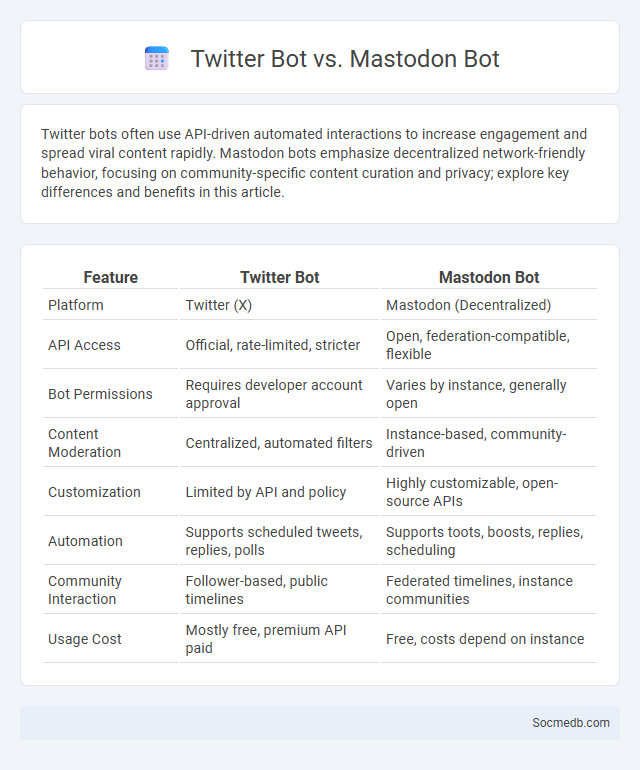
Photo illustration: Twitter Bot vs Mastodon Bot
Twitter bots often use API-driven automated interactions to increase engagement and spread viral content rapidly. Mastodon bots emphasize decentralized network-friendly behavior, focusing on community-specific content curation and privacy; explore key differences and benefits in this article.
Table of Comparison
| Feature | Twitter Bot | Mastodon Bot |
|---|---|---|
| Platform | Twitter (X) | Mastodon (Decentralized) |
| API Access | Official, rate-limited, stricter | Open, federation-compatible, flexible |
| Bot Permissions | Requires developer account approval | Varies by instance, generally open |
| Content Moderation | Centralized, automated filters | Instance-based, community-driven |
| Customization | Limited by API and policy | Highly customizable, open-source APIs |
| Automation | Supports scheduled tweets, replies, polls | Supports toots, boosts, replies, scheduling |
| Community Interaction | Follower-based, public timelines | Federated timelines, instance communities |
| Usage Cost | Mostly free, premium API paid | Free, costs depend on instance |
Introduction: Understanding Social Media Bots
Social media bots are automated programs designed to perform tasks such as posting content, liking, sharing, and following users on platforms like Twitter, Facebook, and Instagram. These bots can influence public opinion, amplify misinformation, and affect engagement metrics by simulating real user behavior. Understanding the mechanisms and impact of social media bots is essential for detecting manipulation and improving platform integrity.
Overview of Twitter Bots
Twitter bots are automated accounts programmed to perform specific tasks such as posting tweets, retweeting content, or following users. These bots can amplify messages, manipulate trends, or spread misinformation, impacting the platform's information ecosystem. Advanced Twitter bots leverage machine learning and natural language processing to engage more authentically and increase their influence on public discourse.
Features and Capabilities of Mastodon Bots
Mastodon bots offer diverse features such as automated posting, content curation, and follower engagement, enhancing your social media experience. These bots can schedule tweets, share relevant posts from specific hashtags, and interact with users through replies or boosts, improving your account's visibility. With customization options and API integration, you can tailor bot behavior to align with your Mastodon community interests and goals.
General Purpose Bots: Applications Beyond Platforms
General purpose bots extend social media capabilities by automating tasks such as content moderation, customer engagement, and personalized recommendations, enhancing user experience across diverse platforms. These bots analyze vast amounts of data to identify trends, manage interactions, and deliver tailored content, helping businesses optimize their social media strategies. Your engagement with social media becomes more efficient and meaningful as these intelligent bots streamline communication and information discovery.
Key Differences: Twitter Bots vs Mastodon Bots
Twitter bots often operate within a centralized platform, enabling automated posting, retweeting, and follower interactions driven by APIs that support extensive data mining and influence campaigns. Mastodon bots function in a decentralized, federated network, allowing for more community-specific moderation, diverse content dissemination, and reduced susceptibility to coordinated misinformation. The contrast in bot behavior reflects the underlying architecture: Twitter's centralized control versus Mastodon's server-to-server communication model, impacting bot scalability, control, and content distribution.
Privacy and Security: Platform Policies on Bots
Social media platforms implement strict privacy and security policies to regulate bot activity, aiming to protect Your personal data from unauthorized access and manipulation. These policies often include verification processes, restrictions on automated behaviors, and monitoring systems to detect malicious bots that could compromise user accounts or spread misinformation. Understanding and adhering to these platform guidelines enhances Your online safety and preserves the integrity of social interactions.
Customization and Development: Building Bots for Each Platform
Customization in social media bot development ensures tailored user interactions that align with platform-specific features and audience behaviors, enhancing engagement and functionality. Building bots for each platform involves leveraging native APIs, adapting to unique interface guidelines, and integrating platform-specific data to optimize performance. This approach maximizes relevance, user satisfaction, and operational efficiency across diverse social media environments.
Use Cases: Popular Examples of Twitter and Mastodon Bots
Twitter and Mastodon bots automate engagement by posting timely updates, monitoring hashtags, and interacting with followers to boost visibility. Popular use cases include news aggregators that deliver real-time headlines, customer service bots handling FAQs, and content curators sharing niche topics aligned with Your interests. These bots enhance social media presence and streamline communication without constant manual input.
Challenges and Limitations of Bots on Social Platforms
Social media bots face significant challenges including the difficulty of distinguishing between genuine user interactions and automated behavior, which limits their effectiveness in fostering authentic engagement. Their impact is constrained by platform detection algorithms that increasingly identify and block suspicious bot activities, reducing their reach and influence. Ethical concerns and regulatory scrutiny further restrict bot usage, as platforms aim to maintain trust and transparency among users.
Future Trends: The Evolution of Social Media Bots
Social media bots are rapidly advancing with the integration of AI, enabling more sophisticated interactions and personalized content delivery across platforms. Future trends highlight the rise of autonomous bots capable of real-time sentiment analysis and adaptive communication, enhancing user engagement and customer service efficiency. Enhanced detection algorithms and ethical guidelines are being developed simultaneously to manage the increasing influence of these intelligent bots on digital ecosystems.
 socmedb.com
socmedb.com